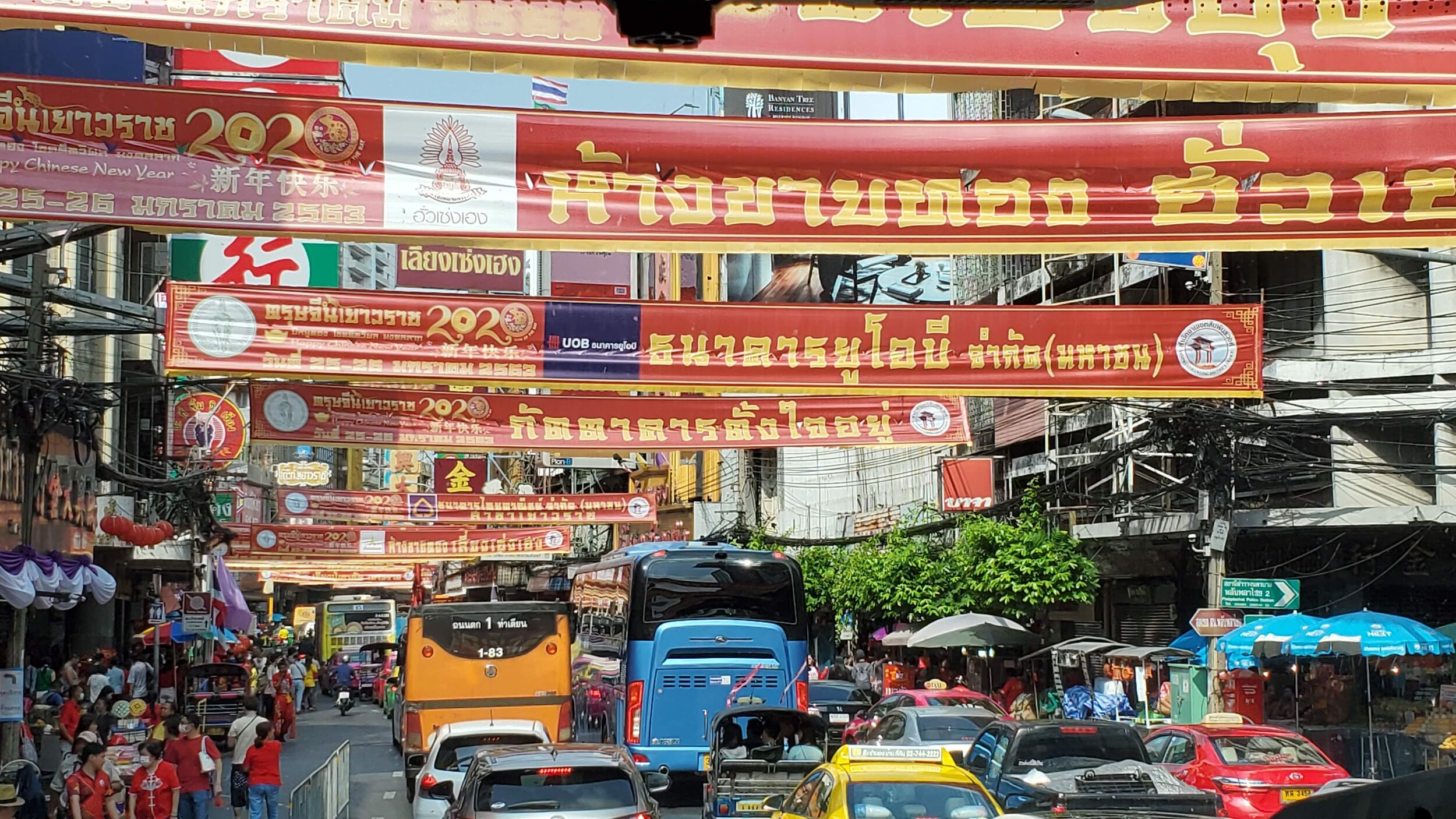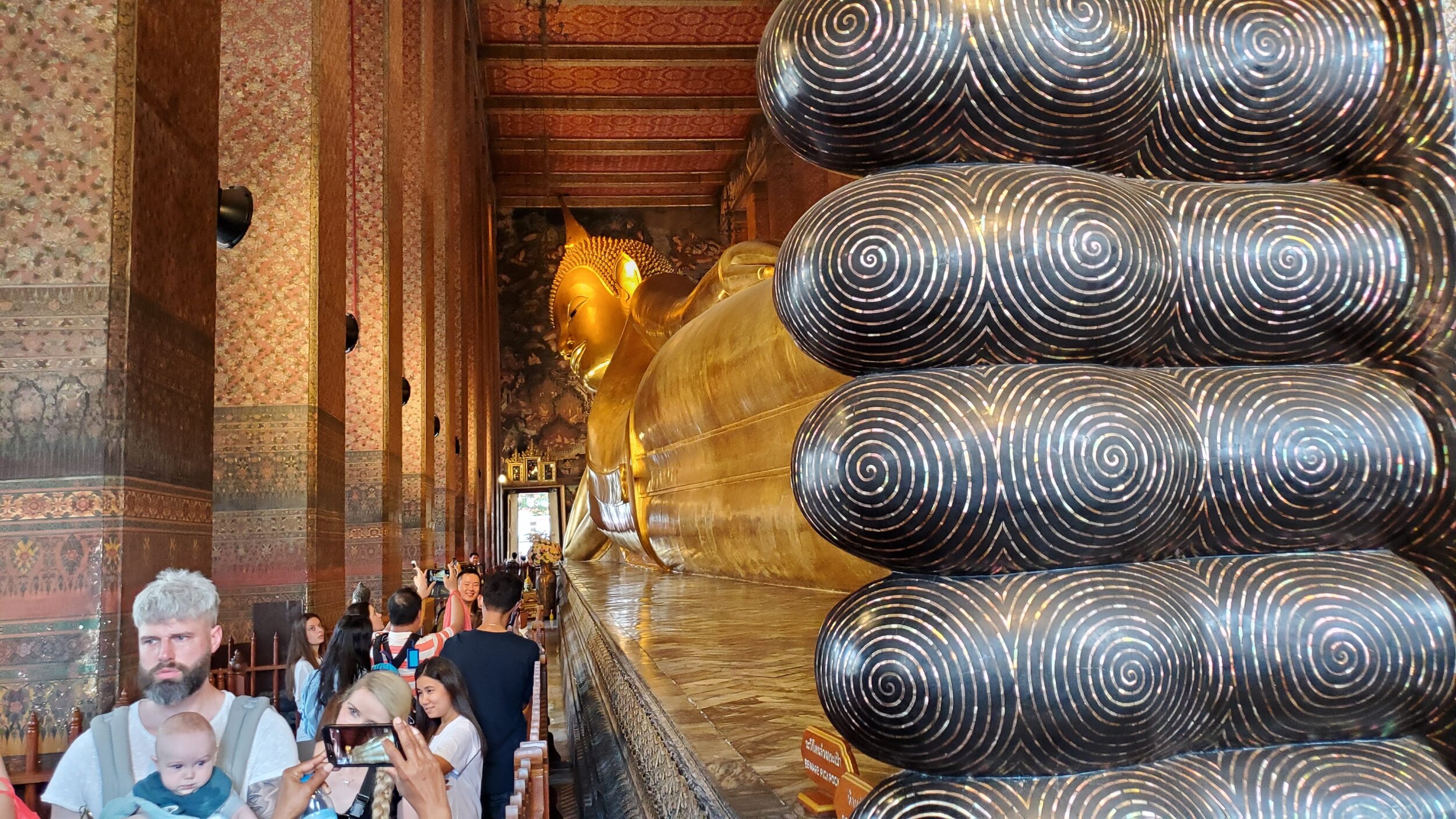Year of the Rat and a Couple of Wats
By Avery Davidson
Louisiana Farm Bureau Federation
“Philosophers and plowmen
Each must know his part
To sow a new mentality
Closer to the heart.”
-Rush Closer to the Heart
Happy New Year! That seems to be the proper thing to say after witnessing a huge celebration of the Chinese New Year in the part of Bangkok known as Chinatown. It is now the Year of the Rat. One could argue that we didn’t just witness this celebration but were right in the middle of it. The big blue bus carrying Class XVI was en route to Wat Pho (said Po, like po-boy, not Fuh like the Vietmese soup), which is where you will find the Temple of the Reclining Buddha. More on that later.
Bangkok Chinatown for Chinese New Year Celebrations.
It was about 1 kilometer (.6 of a mile) outside of Chinatown that traffic came to a slow crawl. A few minutes later, when the bus rolled into Chinatown, we could see the source of the slowdown: thousands of people, most wearing red, the color of good luck, filled the sidewalks and side streets. Bright red banners with gold writing and pictures of rats stretched across the main road one after the other as far as the eye could see. There were also round red paper lanterns strung up between the banners. Open shops were bustling with women and men going in, looking at all of the bright red clothes, flags, lanterns. Outside the shops were tables set up with fresh fruit for sale. At another table, a Thai woman who appeared to be of Chinese descent took a silver ladle of broth from one pot and poured it into another filled with a soup that looked almost like gumbo.
Class XVI took it all in. Ashley Dupree was snapping photos with her trusty iPhone. Shouts of “did you get that?” and “Can you AirDrop it to me?” filled the bus as it creeped along through the congested road through Chinatown. After about 30 minutes of stop and go, but mostly stop, traffic, the 30 Ag Leaders rolled away from pictures of rats and headed toward two Wats.
A Wat is a temple. Our guide, Kit Ja, told us there are 350 temples in Bangkok and about 40,000 in the country of Thailand.
Upon arrival at Wat Pho, before we exit the big blue bus that will be our chariot throughout our time in Thailand, Kit Ja begins handing out chilled bottles of water. He tells us that in the northeastern part of Thailand, there are two seasons: the wet and the hot. He says in Bangkok, there are three: hot, hot and hot. Good thing he gave us the water.
Wat Pho is a huge, ornate complex of buildings housing what seems like hundreds of gold statues of Buddha. The stained glass tiles and alabaster white facades decorated with gold leaf are breathtaking to see in person.
The first chapel we entered was Phra Ubosot (I don’t know how to say it.) Inside, the class saw an alter standing about eight meters high with a large gold statue of Buddha in his seated position at its apex. Followers sat below to pray and pay respect. Members of Class XVI filed through and took in all of the sights and sounds in the chapel.
From there, the group traveled clockwise around the chapel. Kit Ja told the group that it’s only for funerals that people walk counterclockwise around the chapel. We’re all still very much alive, so clockwise we walked.
The entrance to the Temple of the Reclining Buddha gives you no hint to what you’re going to see inside. None. Many in the class thought it was going to be just another statue in a different position. While they were right about the position, this one was not just another statue. The Reclining Buddha is 15 meters high (that’s 45 feet for us on the imperial system) and 46 meters long (150 feet). The entire statue is gold, except for the feet. The soles are black and are decorated with mother-of-pearl in spiral designs on the toes and symbols and building scenes along the arch to the heel. It’s breathtaking.
The Reclining Buddha seen from toes to head.
After leaving Wat Pho, the class boarded a long wooden motorboat of questionable seaworthiness to cross the Chao Phraya River to visit Wat Arun, the Temple of Dawn. Since I’m typing this, you know the boat, despite the cracking multicolor paint and scraped bow, made it safely to all destinations. (We boarded it again after Wat Arun, went on a tour and made it to lunch… and there was much rejoicing.)
Wat Arun: The Temple of Dawn.
Time was short at Wat Arun, but the temple itself was breathtaking. Standing nearly 90 meters high (288 feet) and decorated in colorful porcelain, Class XVI climbed to the first level of the central prang (that’s what the center tower is called, or so I’m told) to see the designs and statues up close.
It was while at Wat Arun that another Chinese New Year celebration broke out. This time, it was a drum on wheels, clanging cymbals and two white Chinese dragons moved around by eight young people. Julie Lively was right up front taking pictures while the performance moved toward Wat Arun.
At lunch, Craig Guidry mentioned to Neil Melançon how different the cultures of Japan and Thailand were from those in the States, but also from each other. He said he had a new understanding and appreciation for the people of both countries and truly enjoyed this cultural excursion. From here on, those on this trip will have a new mentality toward the people of Southeast Asia, closer to the heart.



